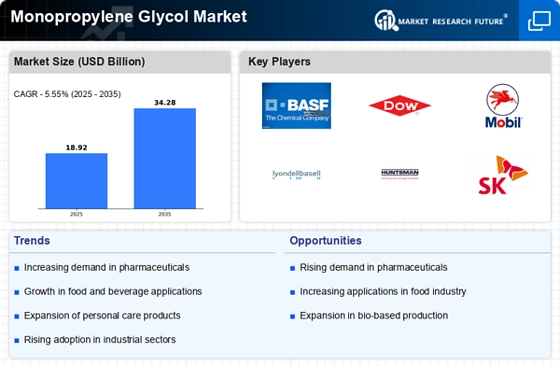Growth in Personal Care and Cosmetics
The Monopropylene Glycol Market is benefiting from the burgeoning personal care and cosmetics sector. This compound is extensively used in formulations for skin care, hair care, and cosmetics due to its properties as a moisturizer and solvent. The increasing consumer inclination towards premium personal care products is likely to drive the demand for Monopropylene Glycol Market, as brands seek to enhance product efficacy and sensory attributes. Market analysis indicates that the personal care segment is expected to witness a steady growth rate, contributing significantly to the overall Monopropylene Glycol Market consumption. As consumers become more discerning about product ingredients, the Monopropylene Glycol Market may see a shift towards more sustainable and natural formulations, further propelling its growth.
Expansion in Pharmaceutical Applications
The Monopropylene Glycol Market is witnessing significant growth due to its expanding applications in the pharmaceutical sector. This compound is recognized for its role as a solvent in various pharmaceutical formulations, including oral, topical, and injectable medications. The increasing prevalence of chronic diseases and the subsequent rise in pharmaceutical production are likely to bolster the demand for Monopropylene Glycol Market. Recent data suggests that the pharmaceutical segment is projected to grow at a compound annual growth rate (CAGR) of over 5% in the coming years. This growth is indicative of the Monopropylene Glycol Market's potential to cater to the evolving needs of pharmaceutical manufacturers, who are increasingly focusing on developing innovative drug delivery systems.
Emerging Markets and Economic Development
The Monopropylene Glycol Market is poised for growth in emerging markets, where economic development is driving increased industrialization and consumer spending. As countries develop, there is a rising demand for various products that utilize Monopropylene Glycol Market, including food, pharmaceuticals, and personal care items. The expansion of middle-class populations in these regions is likely to lead to higher consumption rates of products containing Monopropylene Glycol Market. Market projections suggest that emerging economies could contribute significantly to the overall growth of the Monopropylene Glycol Market, as manufacturers seek to establish a presence in these lucrative markets. This trend may encourage investment in production facilities and distribution networks to meet the anticipated demand.
Rising Demand in Food and Beverage Sector
The Monopropylene Glycol Market is experiencing a notable increase in demand from the food and beverage sector. This compound is widely utilized as a food additive, serving as a humectant, solvent, and flavor carrier. The growing consumer preference for processed and packaged foods is likely to drive the demand for Monopropylene Glycol Market, as manufacturers seek to enhance product quality and shelf life. According to industry estimates, the food and beverage segment accounts for a substantial share of the overall Monopropylene Glycol Market consumption, indicating a robust growth trajectory. As health-conscious consumers continue to seek products with extended freshness, the Monopropylene Glycol Market is poised to benefit from this trend, potentially leading to increased production capacities and innovation in formulations.
Industrial Applications and Growth in Manufacturing
The Monopropylene Glycol Market is also experiencing growth due to its diverse industrial applications. This compound is utilized in the production of antifreeze, de-icing agents, and as a coolant in various industrial processes. The expansion of manufacturing activities across sectors such as automotive, construction, and chemical processing is likely to drive the demand for Monopropylene Glycol Market. Recent statistics indicate that the industrial segment is projected to account for a significant portion of the overall market share. As industries continue to seek efficient and effective solutions for temperature control and fluid management, the Monopropylene Glycol Market is expected to play a crucial role in meeting these demands.


















Leave a Comment